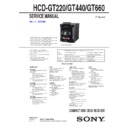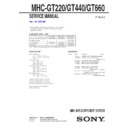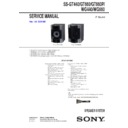Sony HCD-GT220 / HCD-GT440 / HCD-GT660 / MHC-GT220 / MHC-GT440 / MHC-GT660 Service Manual ▷ View online
SERVICE MANUAL
Sony Corporation
Published by Sony Techno Create Corporation
HCD-GT220/GT440/GT660
SPECIFICATIONS
COMPACT DISC DECK RECEIVER
9-889-415-02
2012B33-1
©
2012.02
E Model
Ver. 1.1 2012.02
• HCD-GT220 is the amplifer, USB, CD player, tape
deck and tuner section in MHC-GT220.
• HCD-GT440 is the amplifer, USB, CD player, tape
deck and tuner section in MHC-GT440.
• HCD-GT660 is the amplifer, USB, CD player, tape
deck and tuner section in MHC-GT660.
Photo: HCD-GT660
CD
Section
Section
Model Name Using Similar Mechanism
HCD-GT22
CD Mechanism Type
CDM74KF-K6BD91UR-WOD
Base Unit Name
BU-K6BD91UR-WOD74
Optical Pick-up Block Name
KSM-213DCP
TAPE
Section
Section
Model Name Using Similar Mechanism
HCD-GT22
Tape Transport Mechanism Type
CWN42FF609
• “WALKMAN” and “WALKMAN”
logo are registered trademarks of Sony
Corporation.
Corporation.
• MICROVAULT is a trademark of Sony
Corporation.
• MPEG Layer-3 audio coding
technology and patents licensed from
HCD-GT660
240V 50/60Hz
Front speaker
Front speaker
Power output (rated): 110 W + 110 W
(at 6 Ω, 1 kHz, 1% THD)
RMS output power (reference):
200 W + 200 W (per channel at 6 Ω,
1 kHz, 10% THD)
(at 6 Ω, 1 kHz, 1% THD)
RMS output power (reference):
200 W + 200 W (per channel at 6 Ω,
1 kHz, 10% THD)
Subwoofer
RMS output power (reference): 200 W
(at 6 Ω, 80 Hz, 10% THD)
(at 6 Ω, 80 Hz, 10% THD)
HCD-GT440
240V 50/60Hz
Front speaker
Front speaker
Power output (rated): 90 W + 90 W
(at 6 Ω, 1 kHz, 1% THD)
RMS output power (reference):
160 W + 160 W (per channel at 6 Ω,
1 kHz, 10% THD)
(at 6 Ω, 1 kHz, 1% THD)
RMS output power (reference):
160 W + 160 W (per channel at 6 Ω,
1 kHz, 10% THD)
Subwoofer
RMS output power (reference): 155 W
(at 6 Ω, 80 Hz, 10% THD)
(at 6 Ω, 80 Hz, 10% THD)
HCD-GT220
240V 50/60Hz
Power output (rated): 110 W + 110 W
(at 6 Ω, 1 kHz, 1% THD)
RMS output power (reference):
205 W + 205 W (per channel at 6 Ω,
1 kHz, 10% THD)
(at 6 Ω, 1 kHz, 1% THD)
RMS output power (reference):
205 W + 205 W (per channel at 6 Ω,
1 kHz, 10% THD)
Inputs
AUDIO (phono jack): voltage 250 mV,
impedance 47 kilohms
MIC (phone jack): sensitivity 1 mV,
impedance 10 kilohms
impedance 47 kilohms
MIC (phone jack): sensitivity 1 mV,
impedance 10 kilohms
(USB) port: Type A
Outputs
PHONES (stereo mini jack): accepts
headphones of 8 Ω or more
SPEAKER: accepts impedance of 6 to 16 Ω
SUB WOOFER OUT (MHC-GT660/GT440
only): accepts impedance of 6 to 16 Ω
headphones of 8 Ω or more
SPEAKER: accepts impedance of 6 to 16 Ω
SUB WOOFER OUT (MHC-GT660/GT440
only): accepts impedance of 6 to 16 Ω
USB section
Supported bit rate
MP3 (MPEG 1 Audio Layer-3):
32
32
320 kbps, VBR
Sampling frequencies
MP3 (MPEG 1 Audio Layer-3):
32/44.1/48 kHz
32/44.1/48 kHz
Transfer speed
Full-Speed
Supported USB device
Mass Storage Class
Maximum current
500 mA
CD player section
System: Compact disc and digital audio
system
Laser Diode Properties
system
Laser Diode Properties
Emission Duration: Continuous
Laser Output*: Less than 44.6μW
Laser Output*: Less than 44.6μW
*
at a distance of 200mm from the
objective lens surface on the Optical
Pick-up Block with 7mm aperture.
objective lens surface on the Optical
Pick-up Block with 7mm aperture.
Frequency response: 20 Hz
20 kHz
Signal-to-noise ratio: More than 90 dB
Dynamic range: More than 88 dB
Dynamic range: More than 88 dB
Tape deck section
Recording system: 4-track 2-channel, stereo
Frequency response: 50
Frequency response: 50
13,000 Hz (±3
dB), using Sony TYPE I cassettes
Tuner section
FM stereo, FM/AM superheterodyne tuner
FM tuner section:
Tuning range:
87.5
108.0 MHz (50 kHz step)
Antenna: FM lead antenna
Antenna terminals: 75 ohms unbalanced
Intermediate frequency: 10.7 MHz
Antenna terminals: 75 ohms unbalanced
Intermediate frequency: 10.7 MHz
AM tuner section:
Tuning range
530
1,610 kHz (with 10 kHz tuning
interval)
531
531
1,602 kHz (with 9 kHz tuning
interval)
Antenna: AM loop antenna, external
antenna terminal
Intermediate frequency: 450 kHz
antenna terminal
Intermediate frequency: 450 kHz
General
Power requirements
AC 120, 220 or 230
240 V,
50/60 Hz, Adjustable with voltage
selector
selector
Power consumption
HCD-GT660: 225 W
HCD-GT440: 250 W
HCD-GT220: 150 W
HCD-GT440: 250 W
HCD-GT220: 150 W
Dimensions (w/h/d) (excl. speakers)
HCD-GT660:
Approx. 280 × 365 ×425 mm
HCD-GT440/GT220:
Approx. 280 × 325 ×425 mm
Approx. 280 × 365 ×425 mm
HCD-GT440/GT220:
Approx. 280 × 325 ×425 mm
Mass (excl. speakers)
HCD-GT660: 10.5 kg
HCD-GT440/GT220: 10.0 kg
HCD-GT440/GT220: 10.0 kg
change without notice.
HCD-GT220/GT440/GT660
2
NOTES ON CHIP COMPONENT REPLACEMENT
•
•
Never reuse a disconnected chip component.
•
Notice that the minus side of a tantalum capacitor may be dam-
aged by heat.
aged by heat.
FLEXIBLE CIRCUIT BOARD REPAIRING
•
•
Keep the temperature of soldering iron around 270 °C during
repairing.
repairing.
•
Do not touch the soldering iron on the same conductor of the
circuit board (within 3 times).
circuit board (within 3 times).
•
Be careful not to apply force on the conductor when soldering
or unsoldering.
or unsoldering.
SAFETY-RELATED COMPONENT WARNING!
COMPONENTS IDENTIFIED BY MARK 0 OR DOTTED LINE
WITH MARK 0 ON THE SCHEMATIC DIAGRAMS AND IN
THE PARTS LIST ARE CRITICAL TO SAFE OPERATION.
REPLACE THESE COMPONENTS WITH SONY PARTS
WITH MARK 0 ON THE SCHEMATIC DIAGRAMS AND IN
THE PARTS LIST ARE CRITICAL TO SAFE OPERATION.
REPLACE THESE COMPONENTS WITH SONY PARTS
WHOSE PART NUMBERS APPEAR AS SHOWN IN THIS
MANUAL OR IN SUPPLEMENTS PUBLISHED BY SONY.
MANUAL OR IN SUPPLEMENTS PUBLISHED BY SONY.
CAUTION
Use of controls or adjustments or performance of procedures
other than those specifi ed herein may result in hazardous radia-
tion exposure.
Use of controls or adjustments or performance of procedures
other than those specifi ed herein may result in hazardous radia-
tion exposure.
This appliance is classifi ed as
a CLASS 1 LASER product.
This marking is located on the
rear exterior.
a CLASS 1 LASER product.
This marking is located on the
rear exterior.
HCD-GT220/GT440/GT660
3
1.
SERVICING NOTES
............................................. 4
2. GENERAL
.................................................................. 6
3. DISASSEMBLY
3-1. Disassembly Flow ........................................................... 7
3-2. Case (Side-L), Case (Side-R) .......................................... 8
3-3. Case (Top) ....................................................................... 8
3-4. LID (CD) ......................................................................... 9
3-5. CD Mechanism Deck, USB R Board .............................. 9
3-6. Front Panel Block ........................................................... 10
3-7. Mecha Deck (CWM42FF609) ........................................ 10
3-8. Back Panel Block ............................................................ 11
3-9. MAIN Board, POWER Board ........................................ 11
3-10. CD Board ........................................................................ 12
3-11. DRIVER Board, SW Board ............................................ 12
3-12. Optical Pick-up Block (KSM-213D) .............................. 13
3-13. SENSOR Board .............................................................. 13
3-14. MOTOR (TB) Board....................................................... 14
3-15. MOTOR (LD) Board ...................................................... 14
3-2. Case (Side-L), Case (Side-R) .......................................... 8
3-3. Case (Top) ....................................................................... 8
3-4. LID (CD) ......................................................................... 9
3-5. CD Mechanism Deck, USB R Board .............................. 9
3-6. Front Panel Block ........................................................... 10
3-7. Mecha Deck (CWM42FF609) ........................................ 10
3-8. Back Panel Block ............................................................ 11
3-9. MAIN Board, POWER Board ........................................ 11
3-10. CD Board ........................................................................ 12
3-11. DRIVER Board, SW Board ............................................ 12
3-12. Optical Pick-up Block (KSM-213D) .............................. 13
3-13. SENSOR Board .............................................................. 13
3-14. MOTOR (TB) Board....................................................... 14
3-15. MOTOR (LD) Board ...................................................... 14
4. TEST
MODE
............................................................. 15
5. MECHANICAL
ADJUSTMENTS
...................... 19
6. ELECTRICAL
ADJUSTMENTS
........................ 20
7. DIAGRAMS
7-1. Block Diagram - CD SERVO, USB Section - ................ 23
7-2. Block Diagram - MAIN Section - ................................... 24
7-3. Block Diagram - AMP Section - ..................................... 25
7-4. Block
7-2. Block Diagram - MAIN Section - ................................... 24
7-3. Block Diagram - AMP Section - ..................................... 25
7-4. Block
Diagram
- PANEL, POWER SUPPLY Section - ........................... 26
7-5. Printed Wiring Board - CD Board - ................................ 28
7-6. Schematic Diagram - CD Board - ................................... 29
7-7. Printed Wiring Boards - CHANGE Section - ................. 30
7-8. Schematic Diagram - CHANGE Section - ..................... 31
7-9. Printed Wiring Board - USB R Board - .......................... 32
7-10. Schematic Diagram - USB R Board - ............................. 33
7-11. Printed Wiring Board - TC Board - ................................. 34
7-12. Schematic Diagram - TC Board - ................................... 35
7-13. Printed Wiring Boards - MAIN Section - ....................... 37
7-14. Schematic Diagram - MAIN Section (1/4) - ................... 38
7-15. Schematic Diagram - MAIN Section (2/4) - ................... 39
7-16. Schematic Diagram - MAIN Section (3/4) - ................... 40
7-17. Schematic Diagram - MAIN Section (4/4) - ................... 41
7-18. Printed Wiring Board - MIC Board - .............................. 42
7-19. Schematic Diagram - MIC Board - ................................. 43
7-20. Printed Wiring Board
7-6. Schematic Diagram - CD Board - ................................... 29
7-7. Printed Wiring Boards - CHANGE Section - ................. 30
7-8. Schematic Diagram - CHANGE Section - ..................... 31
7-9. Printed Wiring Board - USB R Board - .......................... 32
7-10. Schematic Diagram - USB R Board - ............................. 33
7-11. Printed Wiring Board - TC Board - ................................. 34
7-12. Schematic Diagram - TC Board - ................................... 35
7-13. Printed Wiring Boards - MAIN Section - ....................... 37
7-14. Schematic Diagram - MAIN Section (1/4) - ................... 38
7-15. Schematic Diagram - MAIN Section (2/4) - ................... 39
7-16. Schematic Diagram - MAIN Section (3/4) - ................... 40
7-17. Schematic Diagram - MAIN Section (4/4) - ................... 41
7-18. Printed Wiring Board - MIC Board - .............................. 42
7-19. Schematic Diagram - MIC Board - ................................. 43
7-20. Printed Wiring Board
- AMP Board (GT220/GT660) - ..................................... 44
7-21. Schematic Diagram - AMP Board (GT220/GT660) - ..... 45
7-22. Printed Wiring Board - AMP Board (GT440) - .............. 46
7-23. Schematic Diagram - AMP Board (GT440) - ................. 47
7-24. Printed Wiring Boards
7-22. Printed Wiring Board - AMP Board (GT440) - .............. 46
7-23. Schematic Diagram - AMP Board (GT440) - ................. 47
7-24. Printed Wiring Boards
- SUB WOOFER Section (GT440/GT660) - .................. 48
7-25. Schematic Diagram
- SUB WOOFER Section (GT440/GT660) - .................. 49
7-26. Printed Wiring Boards - PANEL Section - ..................... 50
7-27. Schematic Diagram - PANEL Section - .......................... 51
7-28. Printed Wiring Boards - KEY Section - .......................... 52
7-29. Schematic Diagram - KEY Section - .............................. 53
7-30. Printed Wiring Board
7-27. Schematic Diagram - PANEL Section - .......................... 51
7-28. Printed Wiring Boards - KEY Section - .......................... 52
7-29. Schematic Diagram - KEY Section - .............................. 53
7-30. Printed Wiring Board
- TRANSFORMER Board (GT220/GT660) - ................ 54
TABLE OF CONTENTS
7-31. Schematic Diagram
- TRANSFORMER Board (GT220/GT660) - ................ 55
7-32. Printed Wiring Board
- TRANSFORMER Board (GT440) -............................. 56
7-33. Schematic Diagram
- TRANSFORMER Board (GT440) -............................. 57
8.
EXPLODED VIEWS
8-1. Case Section .................................................................... 66
8-2. KEY TOP Board Section ................................................ 67
8-3. TC Mecha Deck Section ................................................. 68
8-4. PANEL Board Section .................................................... 69
8-5. Front Panel Section ......................................................... 70
8-6. MAIN Board Section ...................................................... 71
8-7. POWER Board, SUB WOOFER Board Section ............ 72
8-8. Chassis Section ............................................................... 73
8-9. CD Mechanism Deck, Section-1
(CDM74KF-K6BD91UR-WOD)
8-2. KEY TOP Board Section ................................................ 67
8-3. TC Mecha Deck Section ................................................. 68
8-4. PANEL Board Section .................................................... 69
8-5. Front Panel Section ......................................................... 70
8-6. MAIN Board Section ...................................................... 71
8-7. POWER Board, SUB WOOFER Board Section ............ 72
8-8. Chassis Section ............................................................... 73
8-9. CD Mechanism Deck, Section-1
(CDM74KF-K6BD91UR-WOD)
...................................
74
8-10. CD Mechanism Deck, Section-2
(CDM74KF-K6BD91UR-WOD)
(CDM74KF-K6BD91UR-WOD)
...................................
75
9.
ELECTRICAL PARTS LIST
.............................. 76
Accessories are given in the last of the electrical parts list.
HCD-GT220/GT440/GT660
4
SECTION 1
SERVICING NOTES
NOTES ON HANDLING THE OPTICAL PICK-UP
BLOCK OR BASE UNIT
BLOCK OR BASE UNIT
The laser diode in the optical pick-up block may suffer electrostat-
ic break-down because of the potential difference generated by the
charged electrostatic load, etc. on clothing and the human body.
During repair, pay attention to electrostatic break-down and also
use the procedure in the printed matter which is included in the
repair parts.
The fl exible board is easily damaged and should be handled with
care.
ic break-down because of the potential difference generated by the
charged electrostatic load, etc. on clothing and the human body.
During repair, pay attention to electrostatic break-down and also
use the procedure in the printed matter which is included in the
repair parts.
The fl exible board is easily damaged and should be handled with
care.
NOTES ON LASER DIODE EMISSION CHECK
The laser beam on this model is concentrated so as to be focused
on the disc refl ective surface by the objective lens in the optical
pickup block. Therefore, when checking the laser diode emission,
observe from more than 30 cm away from the objective lens.
The laser beam on this model is concentrated so as to be focused
on the disc refl ective surface by the objective lens in the optical
pickup block. Therefore, when checking the laser diode emission,
observe from more than 30 cm away from the objective lens.
UNLEADED SOLDER
Boards requiring use of unleaded solder are printed with the lead-
free mark (LF) indicating the solder contains no lead.
(Caution: Some printed circuit boards may not come printed with
Boards requiring use of unleaded solder are printed with the lead-
free mark (LF) indicating the solder contains no lead.
(Caution: Some printed circuit boards may not come printed with
the lead free mark due to their particular size)
: LEAD FREE MARK
Unleaded solder has the following characteristics.
• Unleaded solder melts at a temperature about 40 °C higher
• Unleaded solder melts at a temperature about 40 °C higher
than ordinary solder.
Ordinary soldering irons can be used but the iron tip has to be
applied to the solder joint for a slightly longer time.
applied to the solder joint for a slightly longer time.
Soldering irons using a temperature regulator should be set to
about 350 °C.
Caution: The printed pattern (copper foil) may peel away if
about 350 °C.
Caution: The printed pattern (copper foil) may peel away if
the heated tip is applied for too long, so be careful!
• Strong
viscosity
Unleaded solder is more viscous (sticky, less prone to fl ow)
than ordinary solder so use caution not to let solder bridges
occur such as on IC pins, etc.
than ordinary solder so use caution not to let solder bridges
occur such as on IC pins, etc.
• Usable with ordinary solder
It is best to use only unleaded solder but unleaded solder may
also be added to ordinary solder.
also be added to ordinary solder.
RELEASING THE ANTITHEFT LOCK
The disc table lock function for the antitheft of an demonstration
disc in the store is equipped.
The disc table lock function for the antitheft of an demonstration
disc in the store is equipped.
Releasing Procedure:
1. Press the [
1. Press the [
?/1
] button to turn the power on.
2. Press the [CD] button to select “CD”.
3. While pressing the [
3. While pressing the [
x
] button, press the [
Z
] button until “UN-
LOCKED” displayed on the fl uorescent indicator tube (around
5 seconds).
5 seconds).
Note: When
“
LOCKED
”
is displayed, the antitheft lock is not released
by turning power on/off with the
[
?/1
]
button.
HOW TO OPEN THE TRAY WHEN POWER SWITCH
TURN OFF
TURN OFF
Note: Work after removing the side panel refering to SECTION 3 DIS-
ASSEMBLY (page 7).
Turn the gear (loading A)
to the direction of the arrow.



